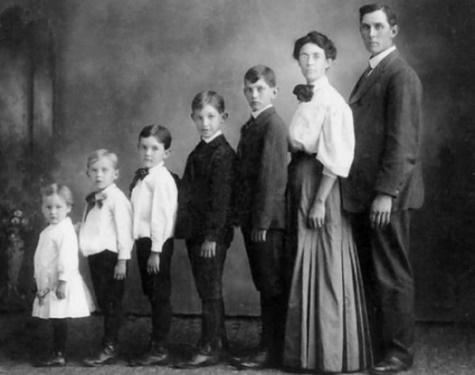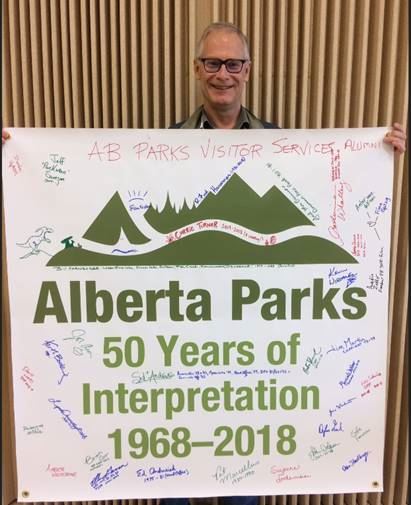by Keith Bocking, Alberta Parks
Bob Townsend was a young university student when, in 1968, he was hired as Cypress Hills’ first Interpretive Naturalist. At the time, I don’t think he thought of himself as being a pioneer for the Alberta Parks system; nor does he know that whenever I see him or think of his story, I picture him as a lodgepole pine tree.
When I worked in the Cypress Hills I was fascinated with the succession that was occurring on the Hills’ plateau. The Cypress Hills are like a bald man’s head: the slopes are forest covered and the flat top is covered with fescue prairie. The key difference is that, unlike the man where he is losing more and more hair up top, the pine forest is reclaiming that turf. This is in part due to the absence of wild fire and the natural process of succession.
 I remember countless examples of pioneer pine becoming established in the grassland. They reminded me of those old black and white family photos where the children were lined up shoulder to shoulder from shortest to tallest. Naturally, the mother and father assumed their respective places on the tallest side. Here in the Hills, the first pine to become established in the grassland would be a stand in for the tallest parent, and ordered typically in a down-wind sequence were other pine of decreasing height and age.
I remember countless examples of pioneer pine becoming established in the grassland. They reminded me of those old black and white family photos where the children were lined up shoulder to shoulder from shortest to tallest. Naturally, the mother and father assumed their respective places on the tallest side. Here in the Hills, the first pine to become established in the grassland would be a stand in for the tallest parent, and ordered typically in a down-wind sequence were other pine of decreasing height and age.
It wouldn’t have been easy to be that first pioneer pine. The Cypress Hills’ plateau is a harsh environment pummeled by wind and frequent storms year around, and at times extended periods of drought and heat. But once that first pine was in place, once the foothold was established, this first pine created an easier environment for the next, and others that followed.
In 2018, Alberta Parks’ celebration of 50 years of interpretive and educational services recognized our early pioneers. Bob Townsend was the first hired into a dedicated naturalist position in the summer of 1968 in these same Cypress Hills. I often pictured him like one of those pioneers who against all odds became rooted like a pine tree in the Hills’ grassland.
But through the year and in discussions with other former Alberta Parks staff, I learned that interpretive services were being provided ahead of 1968 at places such as Dinosaur Provincial Park as part of the range of duties provided by Park Ranger and interested maintenance staff. (My metaphor of pioneer lodgepole pine doesn’t quite fit the badlands environment of Dinosaur Provincial Park though – I will have to ponder that some more.)
Bigger picture, Alberta Parks was part of the larger national and international efforts at expanding interpretive and educational services within federal, provincial and municipally operated parks across the globe. Parks Canada had formally established their program in the late 1950s and Ontario and BC Parks were also forerunners in providing these services for park visitors. So, playing on this ecological parallel, it was sort of like convergent evolution. It had become a good time to launch these services in this continent, country and province.
In the second half of 2017, the Alberta Parks Visitor Experience Coordinating Committee grabbed-on to the idea of celebrating our 50th anniversary; a plan embraced by our program area staff and managers. A 50th anniversary logo was developed and utilized on banners, email signatures, nametags, internal documents and other materials. A Facebook group was also established for past and present staff as a forum to share stories, pictures, information about a potential reunion and celebration plans. The Visitor Services Alumni also bridged with the Alberta Parks Alumni for awareness and sharing information through their membership.
The celebration was launched at the spring Interpretive Training workshop in early May at the William Watson Lodge in Kananaskis Country. The 50th anniversary theme was front and centre – workshop leaders were dressed in uniforms of former eras, and a couple of workshop sessions were led by retired or semi-retired Visitor Services alumni. These folks shared experience and expertise with the full love and caring of mentors who had decades earlier been in the same place as those in attendance that day.
 Throughout the summer of 2018, the anniversary was recognized and celebrated across the province. The 50th anniversary banner was displayed proudly at park Visitor Centres and at programs and special event locations. A team of Interpreters from Kananaskis Country provided out-reach programming at one-half dozen sites including Canada Day celebrations on the Provincial Legislature grounds in Edmonton.
Throughout the summer of 2018, the anniversary was recognized and celebrated across the province. The 50th anniversary banner was displayed proudly at park Visitor Centres and at programs and special event locations. A team of Interpreters from Kananaskis Country provided out-reach programming at one-half dozen sites including Canada Day celebrations on the Provincial Legislature grounds in Edmonton.
September saw one of the key events of the anniversary unfold at Dinosaur Provincial Park. A reunion campout was enthusiastically embraced by 40 or so past and present staff. In short it was a delight: demonstrations of interpretive services and behind the scenes tours, lots of laughter and story telling! Two of the outcomes of our campout were to carry on with a semi-formalized alumni and to set our goals on our next reunion activities including a campout in two years time. In many ways, the formation of an alumni has been one of the biggest achievements. Our membership by the end of 2018 was over 250 past and present staff.
Personally, one of the most joyous observations was the easy gathering of present and past staff to ask questions, gain multi-generational insights and to hear of the experiences and challenges those in trenches today face. A commitment was made to look at ways for continued engagement between the alumni and present program staff – such things as leading sessions at the annual spring workshop, as was done earlier in the year, and through professional development of permanent and long term staff.
I started a journal of sorts in 2018 with notes from impromptu interviews of our “pioneer pines”. Bob Townsend and I have remained friends and I did see him following the campout – but others made their way into the pages as well. My questions were these: how did this all unfold and what were the driving forces behind the Visitor Services program in those early days? What drove the program and the staff? The observations and stories shared will be incorporated into a blog in the near future.
A recent visit to the Cypress Hills left me surprised at how common lodgepole pine seem to be on the plateau. As well, there seemed to be more mature trees now that were showing signs of their age: dying and broken limbs, and cones a-plenty. It made me laugh. True story, one amphitheatre character I once played was an old crabby pine tree that couldn’t wait to “pass-on”, preferably by natural forces like a wild fire, so that it could open its cones and start a whole new generation of little ones. Maybe in fact its wish has come true. Let’s check back in another 50 years and see how the place looks.
Keith Bocking is the Parkland Area Manager for Alberta Parks' Central Region.